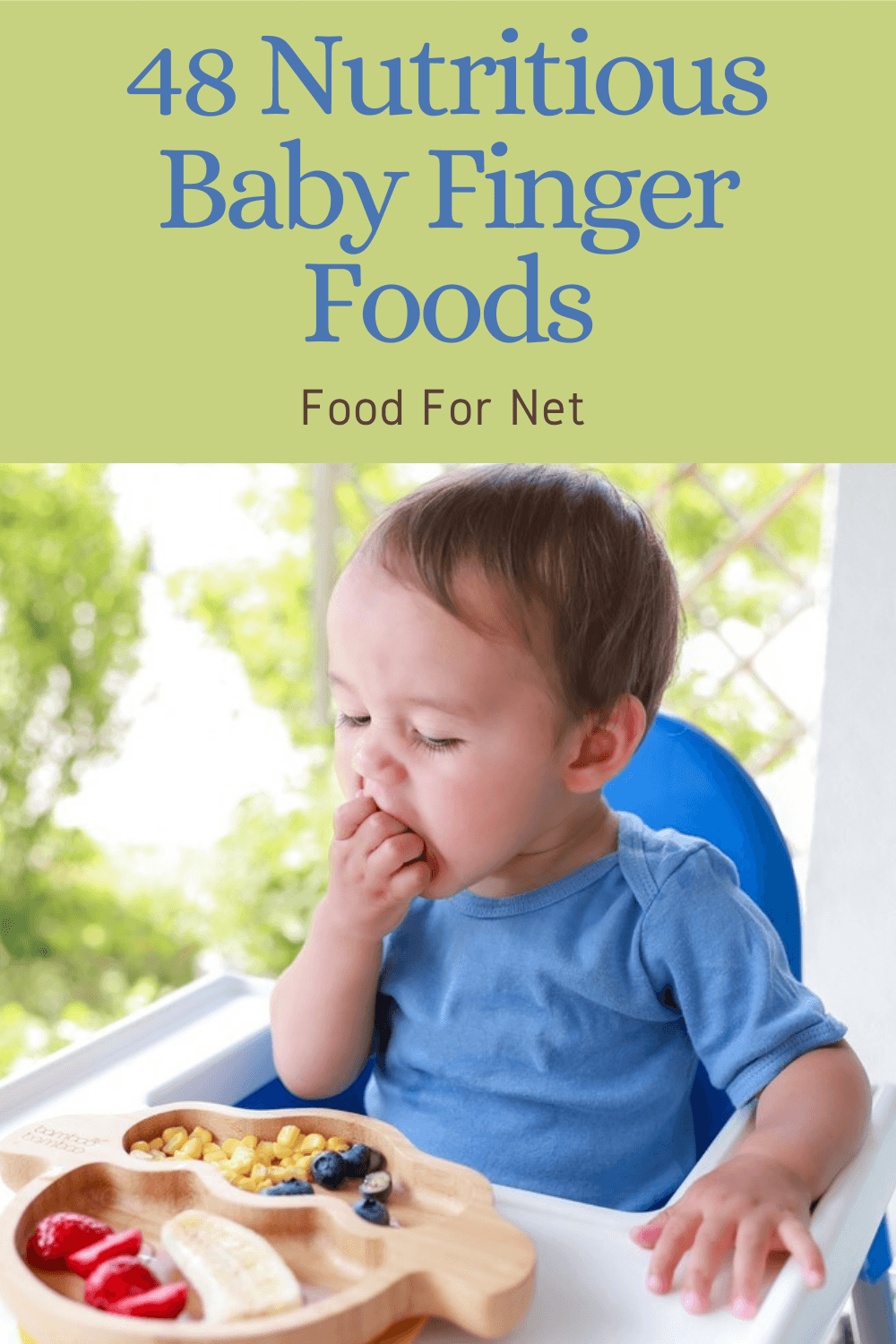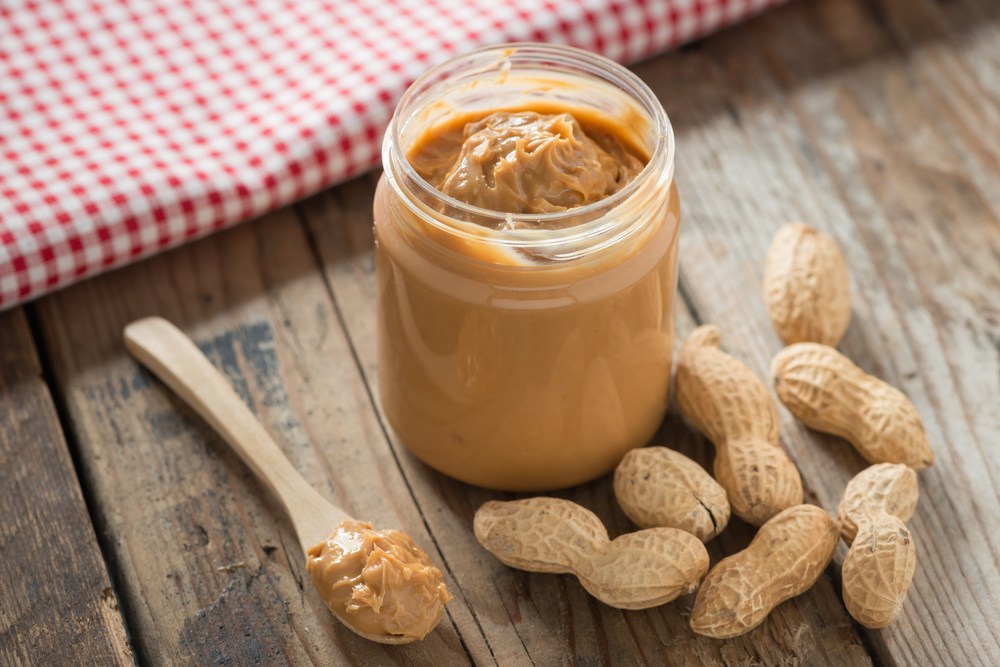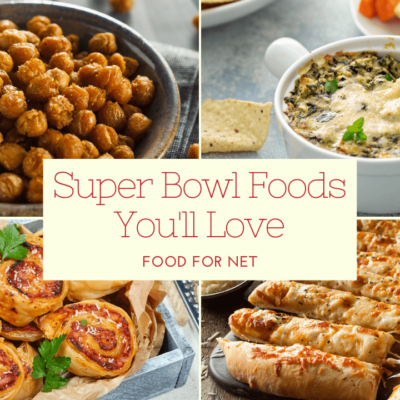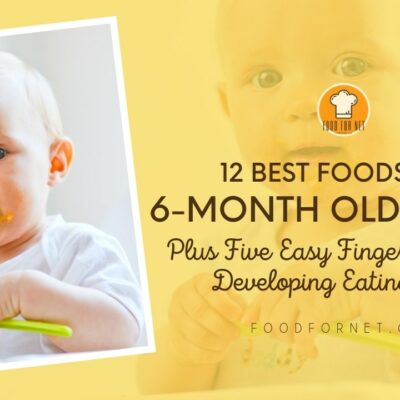
Once your baby is on his or her way with solids, the next important step is finger foods. These might seem a little overwhelming at first, as you can’t serve babies the same finger foods that you’d offer adults. Thankfully, there are plenty of healthy baby finger foods to try.
Finger food are best at around 9 months. This is when babies have developed what’s called a pincer grip, where they can pick up small pieces of food in two fingers. The grip means that the baby can feed themselves, which makes life a little easier for Mum and Dad.
When first starting with finger foods, it’s important to focus on foods that are easy for the baby to pick up and to eat. This means using soft foods that have been broken up into small pieces. Pieces should be a similar size to a pea. If you’re using food that’s been cut into strips, aim for no larger than 2 to 3 inches per strip.
Baby Finger Foods
Vegetables

Vegetables are always important, as they contain so many vital nutrients. It’s also surprisingly easy to get babies to eat vegetables. They don’t start getting picky until a little later in life. Introducing your baby to a wide variety of foods when they’re young helps to set them up for later in life and might stop them from being picky eaters.
Most vegetables are too tough for babies on their own, so they’ll need to be cooked first.
Try cooking the vegetables with some herbs or spices to make them taste even better. Healthy fats can be helpful too. Just be sure to introduce your baby to each type of food on its own first.
Bell Peppers

Bell peppers are an easy place to begin, as you shouldn’t need to cook them. You can serve them raw in short strips instead or diced into small pieces.
Red bell peppers are the sweetest option and the one that most adults prefer eating raw. But, you can orange, yellow, and green peppers too. Your baby might enjoy seeing the different colors on their plate.
Of course, serving bell peppers raw isn’t your only option. You could try roasting them instead, then cut them into the same short strips. Roasting the peppers makes them a little sweeter and softer.
Cherry Tomatoes

Here’s another easy one. Cherry tomatoes can be served raw. Plus, they’re easier to cut into pieces than large tomatoes.
A full cherry tomato is too large for most babies to eat safely, so cut it up into quarters or eighths.
And yes, we know that tomatoes are technically a type of fruit. For lists like these, it’s always easiest to separate foods based on how people use them, rather than the botanical definition.
Cucumber

Cucumbers can be served raw too, but they’re a little more involved than bell peppers and cherry tomatoes, as you need to take the seeds out. Once you’ve done this, the cucumber can be cut into small pieces or strips.
Broccoli

While it might be tough to get kids to eat broccoli, babies will often enjoy the cruciferous vegetable. First though, you need to cook it. Try steaming or roasting the broccoli. Both approaches work well.
Why not play around with seasoning as well? Drizzling a little olive oil over the top is an easy way to make broccoli taste more interesting. A little seasoning doesn’t hurt either. You could even use a tiny bit of parmesan cheese.
You have two main options for serving the broccoli. One is to cut it up into small pieces. The other is to cut broccoli florets lengthwise so that they are thin and flat.
When babies are a little older, you can also serve whole broccoli florets. If you leave enough stem on them, the baby can use this as a handle to hold the broccoli and eat it that way.
Cauliflower

Cauliflower is similar to broccoli, so you can prepare them in the same way. Steaming cauliflower takes around 4 or 5 minutes, while baking it takes closer to 20 minutes.
Cauliflower doesn’t have much flavor of its own, so it’s often best to season the vegetable. Try using your favorite herbs or spices, but start off with just one at a time. Babies don’t need the same complex flavors that adults look for.
You could also try your hand at cauliflower rice. This is usually made as a low carb alternative to rice and happens to be a good choice for babies too. Some cauliflower fried rice recipes could be delicious for your baby too, just be sure to pay attention to the amount of sodium present.
Corn

You have plenty of options with corn. Babies can eat raw or cooked corn (including corn that’s been cooked on the grill). Butter is the most obvious to flavor the corn, as long as you only use a little butter. After all, butter is high in calories.
If your baby is young, it’s best to serve corn kernels on their own. So, if you’re cooking corn on the cob, you’ll need to cut the cooked kernels off and put them on a plate.
Older babies can eat corn on the cob, but you’ll need to cut the cob into rounds of roughly 2 inches or so.
Zucchini

Zucchini is already soft, so it doesn’t need much cooking. You should just be able to steam it for a few minutes and then cut into strips or small pieces. Once the pieces have cooled a little, they should be easy for small fingers to pick up and eat.
Alternatively, you could cut the raw zucchini up into circular coins and sauté these. Using butter or coconut oil as the fat for sautéing helps to add some extra flavor, along with whatever seasonings you throw in.
Asparagus

Asparagus needs to be cooked before serving. Steaming it will take just a few minutes, while roasting takes quarter of an hour or so.
The rest is predictable. You’ll need to cut the asparagus up in to similar pieces as the other foods. So, strips of 2-3 inches (or even smaller for young babies) or small cubes.
Once again, you can serve asparagus plain or add some flavoring. A little rosemary or garlic powder is enough to make asparagus much more interesting.
Peas

Peas are already the right size for your baby, so you just need to cook them. This is easy too. They can be steamed, boiled in a pot of water or sautéed in just a few minutes. You can even cook peas from frozen.
Potatoes and Sweet Potatoes

These two vegetables have many similarities. They’re both carb rich, delicious, and have a similar texture once they’re cooked. Sweet potatoes are arguably healthier than white potatoes, due to their nutrient profile and antioxidant content.
On the other hand, the blander flavor of white potatoes can be more appealing to some eaters. Of course, this isn’t a competition. You don’t need to choose between white potatoes and sweet potatoes. Variety is important and the best approach is to serve your baby both types.
An easy way to serve these tubers is to cook them and them mash them, perhaps with a little butter. Then allow the mashed potatoes to cool a little and break them up so you have small pieces that are easy to grab.
You could also take a cooked potato and cut it up into small cubes. Make sure that the potato is soft enough for your baby to enjoy it.
Carrots

Raw carrots are too hard for babies under 12 months of age. Hard foods like this are difficult to eat and swallow. It’s also too easy for chunks to break off, which could make the baby choke.
You’ll need to cook the carrots first. They should be soft enough that they squish under your finger. Getting the texture right might take some trial and error. After all, too soft isn’t good either, as the baby won’t be able to pick it up.
When cutting the carrot, focus on square pieces or short sticks. Carrot rounds can sometimes be a choking hazard too.
While orange carrots are the most common type, you can find other carrots too, including purple ones. The more unusual colors are just as appealing as orange ones.
Squash

Pumpkin and other types of squash can be baked in the oven with a little butter or oil for about half an hour. The goal is to get it completely tender. You can chop it into cubes or strips, but either way you may need to mash it slightly to make it softer.
You have many options for flavoring. Most types of squash will pair well with sweet or savory seasonings. You can experiment with both combinations to see which one your baby prefers.
Buying a whole squash for a baby finger food might seem like too much, but you can find other uses for the test of it. Some stores also sell chunks of squash, particularly pumpkin.
Beets

Beets are surprisingly complicated. This is simply because there are many ways to serve beets, along with a few different types. If you plan to serve beets regularly, look for golden beets. They have a similar nutritional profile. Plus, many people think that golden beets taste better.
There’s another advantage too – the color. The golden color means you don’t have red juice everywhere, so cleanup is much easier.
Babies can eat beets raw or cooked. Raw is the simplest option. You can just grate the beets, then rinse and dry the grated vegetable. Grated beets are as easy to pick up as grated cheese, making them perfect as finger food.
If you don’t mind the work, cooking the beets is an option too. There are plenty of recipes online. Some will use seasonings that make the beets taste even better.
Don’t forget about canned beets either. These beets are normally precooked, so you can just drain them and chop them. This is much easier than cooking the beets yourself.
Mushrooms

Mushrooms might be a fungi rather than a vegetable, but they’re still a good choice for babies. You’ll need to sauté them in some type of cooking fat first.
Keep the pieces to the same size as other foods and you’re good to go. You can add extra flavoring if needed, although the cooking fat often flavors your mushrooms nicely anyway.
Fruits

Fruit is one of the easiest choices for finger food. It doesn’t need to be cooked and there’s little prep work too. Sometimes all you need to do is break the fruit apart a little. This can be perfect if you need something to feed baby while you’re on the go.
The sweetness of fruit is an advantage too. It means that babies are often more open to fruit than they are to vegetables.
Bananas

Bananas are easy. They’re already very soft, so you just need to cut them up.
Your first instinct might be to slice the bananas into small disks, but this doesn’t work so well. The slices can end up slippery and are often too big for a baby anyway.
Try breaking the banana up into small chunks by hand instead. This makes it easy to get a good size and shape.
When babies are a little older, you can serve the banana still in its skin. Peel the skin back most the way and leave the stem. This allows babies to hold onto the base of the banana and eat it that way.
Avocado

Avocado is a popular ingredient in baby food too, as it’s already soft and creates a fantastic texture in baby food. When making finger food, you just need to cut the avocado in chunks. You could mash the chunks slightly to make them even softer, depending on the age of your baby.
Pay attention to the size of the chunks. Making them small is important, but if they’re too small, your baby mightn’t be able to pick them up.
Dabbing the avocado with a paper towel before serving can help a little too, as this makes it less slippery.
It’s important to choose your avocado carefully. Make sure it’s ripe and soft. Even slightly over-ripe could be appealing and is better than a slightly hard avocado.
Blueberries

Blueberries are famous for their antioxidant content, which makes them a healthy choice. They also taste delicious and can be easy to work with.
But, despite the small size of these berries, you should still cut them up before serving them. Even cutting them in half should be good enough. If the blueberry is on the large side, try cutting it into quarters instead.
Other Berries

Most other berries work well for babies too. Just make sure they’re entirely safe to eat and have been washed. How you serve them will depend on the berry.
For fleshy berries like strawberries, you can simply cut the fruit into small chunks. If the baby is old enough, you might be able to give them the whole berry to eat.
For options like raspberries, where there are many tiny individual fruit, you can simply break the fruit apart in your hands a little. You don’t need to create tiny pieces, but a whole raspberry is too large for a baby.
Grapes

Like blueberries, you shouldn’t serve grapes to your baby as is. At the very least, they should be cut in half. Cutting them into quarters is even better.
This might seem like too much work, as grapes can be a pain to cut, but whole grapes come with too much risk and can make your baby choke.
Cherries

While most fruit doesn’t require much prep work, cherries take a bit of time. You need to deseed them and serve them cut or in quarters.
Experiment with the type of cherry that you use too. Sweet cherries are more appealing to babies than sour ones, but some of these are juicier than others. Rainer cherries tend to be less juicy, which makes them less messy too.
Apples

Apples can be served cooked or raw. They’re often crisp when raw, but this can still be okay if the apple pieces are small enough.
If you want to cook apples, try sautéing them for a few minutes in some type of cooking fat. A little spice, like cinnamon, can help make the apples more exciting. Sautéed apples are softer than raw ones, so sautéing apples might be the best choice for young babies.
Pears

Pears are similar to apples and you can use them in much the same way. However, you should only serve raw pears if they’re soft enough. Some pears end up being quite hard and might be too much for young babies.
Pineapple

Pineapple is a fun one. The standard approach is to chop it up into small pieces. Canned pineapple might be a better choice than fresh pineapple here, as the fresh stuff is more fibrous.
Some parents mention serving the pineapple as a ring instead. When served this way, babies can pick up the pineapple ring in their fists, hold onto it, and munch it.
Watermelon

Watermelon is another food for babies to pick up and hold. You could give them a wedge of watermelon with the rind attached. This is often easier than small pieces that can get slippery.
Watermelon wedges could also be perfect at a picnic or similar event. This way you don’t need to cut up your baby’s food first. Just be sure to remove the seeds first.
Mango

Mango is a soft and delicious choice. It’s easy to serve too. Just chop it up into the appropriate size.
There’s a catch though – the ripeness of the fruit makes a huge difference. If the mango isn’t ripe enough, it will be too hard for babies to gum easily. If it’s too ripe, then the mango will be too soft to pick up easily.
Stone Fruit

Stone fruits like peaches, nectarines, apricots, and plums can all be good choices for your baby. In all cases, the fruit needs to be ripe and cut into small strips or pieces. You’ll need to remove the stone too.
Protein

Babies can eat many types of protein without any problem. The principles are the same as before. Make sure that the food is soft and that it’s in small pieces.
If you’re serving some type of meat or tofu, keeping the food moist can help too. To do this, try serving the meat in a veggie puree, a marinara sauce, or some other homemade sauce. Your baby won’t be able to eat the sauce well with their fingers, but the extra flavor and moisture is still helpful.
Getting protein in a baby’s diet is important, as this helps their young bodies to develop. Their diet doesn’t need to be all protein, far from it. Instead, it’s often best to mostly focus on vegetables, fruits, and carbs, and include a serving of protein during each meal.
Eggs

While you can serve egg in other ways too, scrambled eggs is one of the easiest places to begin. Once you’ve cooked the eggs, you can easily break them up into small pieces. Scrambled eggs tend to clump together well, making them easy for your baby to eat.
Hard boiled eggs can work well too. You just need to cut the eggs up into small enough pieces and perhaps season them slightly.
Ground Meat

Ground turkey, chicken, and beef can all be cooked and then broken up into small chunks. You can even make slightly more complex versions, like meatballs. Regardless, the goal is to end up with small piece that aren’t too dry.
This is why it’s best to cook the ground meat in some type of sauce. The sauce helps to make the meat taste more interesting too, which is another advantage.
Tofu

Even though tofu doesn’t have much flavor, you mightn’t need to add many flavoring ingredients to serve it to babies. Even plain tofu can be surprisingly well-received. And, if that doesn’t work, try sautéing the tofu with just a little seasoning.
Once again, you’ll need to cut the tofu into small pieces once it is cooked.
Fish

Babies can eat some types of fish. The omega-3 fatty acids and protein makes fish a particularly good addition to their diet.
You will need to choose the fish carefully. Some types of fish contain too much mercury, which isn’t good for your developing baby. Keep away from all types of tuna, along with shark, swordfish, and marlin.
Salmon is a fantastic choice, as it’s a fatty fish and contains plenty of omega-3 fatty acids. Many types of white fish will work well too.
You can cook the fish however you like, then flake it into small pieces that your baby can pick up. Make sure to remove any bones too.
Chicken

Shredded chicken is a popular choice. This can be flavored in many ways to make it more interesting. You could even find recipes that work for you and for your baby.
Just shredding the chicken might not be enough, as some strands of the shredded chicken could be too long for your baby. To avoid any problems, be sure to cut up the chicken before you serve it. The same is true for other types of shredded meat.
There are other ways to prepare chicken too. Just make sure that it’s well cooked and the pieces are the right size. Mixing the chicken in with a little sauce can help to keep it moist, while also adding some extra flavor.
You can do exactly the same with turkey.
Sausages

Babies can eat sausages too. These are an easy choice, as they’re already well-seasoned. Just check the flavor before you serve the sausages, as some will be too spicy.
Once cooked, you just need to let the sausage cool then peel away any casing. After that you can cut the sausage into appropriate pieces.
It’s important to choose your sausages well here. There are fat too many highly processed sausages out there, which aren’t good for you or your baby. Stick to high-quality products instead. The best ones will come from a local butcher’s shop, rather than a grocery store.
Beans

Beans one of the best vegetarian sources of protein. They’re rich in nutrients and you have many types to choose from. To serve them to babies, you need to cook them well and then mash them slightly. This should make them soft enough for the baby to pick up and eat without a problem.
Once again, you can look for baby-friendly recipes that use beans too. The trick is to find simple ones. After all, we’re talking about finger foods, not full meals.
You can also use canned beans. These are already cooked, which makes life easier. However, you’ll still need to strain them and cut them up before serving. Some parents smash them a little with a fork too. This can make them even easier to pick up.
Chickpeas

Other types of legumes are great for babies too, including chickpeas. As with beans, canned chickpeas are already cooked. You just need to rinse them and serve them.
Some babies are fine with the chickpeas as they are. If you’re worried, you could cut the chickpeas in half or crush them a little.
Roasted chickpeas are an option too. These are a little crisper, but not by a large amount. Roasting chickpeas makes it easy to add flavor too.
Cheese

Cheese is always popular and shredded cheese is already in an easy form to pick up and eat. You’re not limited to a single type of shredded cheese either. You could vary the cheese you focus on or even serve two types at once.
Cutting cheese up into small chunks can work well too. Some types of goat’s cheese can be crumbled up instead, including feta. Don’t worry about the distinctive sharpness that comes with feta cheese. Many babies love feta as a snack.
Don’t forget about cheese sticks either. These are large enough that babies can grab them in their hands.
While most cheese is perfect for babies, avoid anything that uses unpasteurized milk. Such cheese will always have unpasteurized written somewhere on the label. The cheese is a problem, as some of the bacteria can be dangerous for babies.
Also be wary of mold ripened cheeses, including blue cheeses and brie. These cheeses can also carry bacteria that’s harmful to babies.
Nut Butter

Nut butter might seem like an odd choice for babies, as nut allergies can be serious. However, recent evidence shows the power of giving babies nuts early in life. Doing so can lower their risk of a nut allergy.
Try serving the nut butter on a piece of bread or toast. Cut this up into small pieces and it should be easy for your baby to feed themselves.
You should check with your baby’s pediatrician before doing this. Ask for advice about when and how to introduce your baby to nuts. That advice will be crucial if there’s any history of nut allergies in your family.
Carbohydrates

Carbs are sometimes seen as a villain these days, with some adults cutting them out almost entirely. Don’t let that pattern influences. Carbs are essential for your baby’s development.
Most benefits will come from using complex carbs and ancient grains, rather than processed and heavily refined carbs. You could still give your baby white bread sometimes, but try to get plenty of healthier grains in the mix too.
Bread

Bread is one of the best foods to start with, as it’s soft and gets even softer once it mixes with saliva in the mouth. When the baby is young, you’ll need small pieces of bread with the crusts cut off. These are the easiest for the baby to handle.
Later on, you can serve simple toppings on the bread, like avocado or a thin layer of peanut butter.
You can do the same with toast as well. Toast is crisper than bread, but it still quickly gets soft in the baby’s mouth.
Oatmeal

Oatmeal is normally a meal that you eat in a bowl with a spoon, so calling it a finger food might seem a little surprising. Still, in practice, oatmeal is perfect for babies. After all, it’s a fantastic source of fiber and offers many nutrients. It can be satisfying too, even if the serving size is small.
To turn oatmeal into a finger food, you just need to cook according to the directions, then allow it to cool. Once the oatmeal has cooled, you can break it apart with your fingers.
This approach works for flavored instant oatmeal and oatmeal that you prepare from scratch. But, if you’re buying the instant stuff, check the package first to make sure all the ingredients are suitable for your baby.
Rice

Rice works well for babies, as it’s mild and is largely non-allergenic. This why you’ll often see it in baby food.
Using rice as a type of finger food is a little tricky. If the rice grains all separate out well, then the pieces are too small for the baby to easily eat. You’re looking for rice that clumps together instead. Medium and short grain rice clumps more than long grain, and having a high ratio of water to rice can lead to clumping too.
Another option is to look for recipes that include other ingredients to help the rice clump up. Cheesy rice is always a fantastic option here.
Rice balls are another way to go. These are often made with sticky rice and they’re easy for the baby to pick up and grab.
O-Shaped Cereal

Dry cereal is a popular choice for babies. The little pieces are easy for the baby to pick up one at a time. While the cereal is dry and a little hard, it mixes with saliva in the baby’s mouth and can be easily eaten.
The ideal is appealing to parents too, as dry cereal doesn’t require any preparation and isn’t messy. Even if the cereal ends up half way around the room, there isn’t any sauce or liquid to worry about, just dry pieces of cereal to pick up.
You’ll need to pay attention to the particular cereal that you buy. Some products are highly processed and contain large amounts of sugar. Look for high-quality products instead, ones where the ingredient list is short and there isn’t too much sugar.
Puff Snacks

These pre-packaged snacks are easy to find in the grocery store. They have similar advantages to O-shaped cereal. Look for small snacks that are easy to pick up, ones that are healthy as well.
Many such snacks will have age recommendations written on them. This makes it easy to work out which snacks are perfect for your baby.
Quinoa

Quinoa is a tiny seed that’s sometimes called a pseudograin or pseudocereal. It has a little more crunch and flavor than rice, but can be used in much the same way. While many adults find quinoa boring on its own, babies will eat it without any flavoring. You can also add some seasoning to make things more interesting.
Quinoa can clump after it’s been cooked. You’ll need to break it apart a little, but keep some clumps so there’s something for the baby to grab.
You can also mix quinoa with other ingredients and create chia balls. Cheese is a good choice here, as it will stick the quinoa seeds together nicely and is always a popular flavor.
Couscous

Couscous is similar to quinoa, except that it cooks much faster. The speed of cooking can be perfect if you need to prepare food in a hurry. You can make balls with couscous just like with quinoa.
Couscous is an interesting little ingredient. The small granules make it look like a type of pseudograin, but this isn’t the case. Instead, couscous is actually a type of pasta. You can even find larger grain versions.
White couscous is the most common, but you can find whole grain couscous as well. The whole grain version should be healthier and is worth hunting for.
Farro

Farro isn’t as well-known as couscous or quinoa. It’s an interesting choice for babies because farro is larger than most other grains. The larger size makes it much easier for babies to pick up farro and eat it.
Farro is cooked in a similar way to other grains, so it’s easy to prepare even if you’ve never cooked farro before.
Pasta

Pasta can be easy, as there are plenty of shapes to choose from. Many of these are perfect for your baby to pick up on their own. Cooking the pasta to al dente often works well. This gives it a little firmness and means the pasta isn’t slimy.
When babies are young, you’ll need to focus on small pieces of pasta. Mini shells can be a good choice. You could even try orzo, which is pasta in the shape of rice. If you use larger pieces of pasta, you’ll need to cut this up before serving.
You can serve pasta on its own, use some seasoning ingredients, or even include sauce. The best approach will depend on your baby’s preferences and how well they can pick food up.
Other Grains and Pseudograins

We’ve mentioned quinoa, rice, oats, wheat, and farro, but there are many other types of grains and pseudograins to choose from too. Babies will be able to eat many of them without a problem.
As always, you need to focus on the making the food soft and easy to grab.
Check with your baby’s pediatrician about any unusual grains too. While babies can eat many foods, there are some unexpected exceptions (like honey). It’s always worth getting an informed opinion about your plans before you get started.
Pancakes

Why not look to prepared foods? Some types can work well, including pancakes.
However, you’ll need to make sure that the pancakes are moist. Adding some yogurt or apple sauce into the mix can help, or you can look for a recipe that is naturally moist.
You might be able to serve whole pancakes if they’re very small, but breaking the pancakes up into small pieces or strips is a much better idea.
Muffins

Muffins can be just as appealing as pancakes, although you’ll need to break them up too. Most muffins will be easier for your baby if they’re soft and moist.
The best approach is to hunt for recipes that are designed as baby finger foods to begin with, like these Baby Led Weaning Muffins. With recipes like this, you can be confident that the muffins will have the right texture for your baby.
You can make egg muffins too. These are often moist and soft, although you’ll need to be careful about the ingredients that you add in. Egg muffins tend to be higher in protein and lower in carbs than regular muffins. Those features can be appealing sometimes.









 8 Sizzling Hot Romance Book of the Month Clubs
8 Sizzling Hot Romance Book of the Month Clubs
Leave a Reply